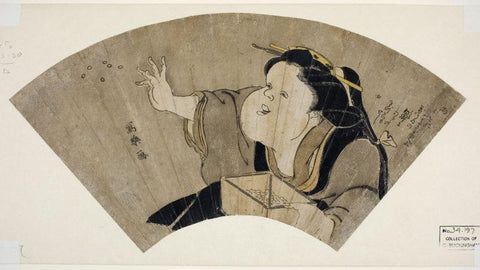Who is Otafuku?

[Public domain], via Wikimedia Commons
Otafuku is a popular figure in Japanese folk tales. Often depicted with large cheeks and a joyful smile, her name translates to “much good fortune” or “plenty of happiness”. She’s known as a goddess of mirth in the Shinto religion, and is often seen with Hyottoko, a god of wind or Fukusuke, a male counterpart who also represents happiness and good luck.
Ame no Uzume

A Japanese legend tells of how the sun goddess, Amaterasu Omikami, became angry with her brother and hid away in a heavenly cave, plunging the world into darkness and disorder. The other gods came together to discuss how to bring the sun back into the world. According to Amy Katoh’s retelling of the story, the gods hung a mirror on a sacred tree and one of the goddesses, Ame no Uzume no Mikoto, performed a humorous dance that caused all the gods to laugh loudly. When Amaterasu Omikami became curious and peeked out of the cave, she was dazzled by her reflection in the mirror and came out of the cave. The gods were able to pull her back into the world while another god placed a sacred rope across the entrance of the cave so that she could not hide her light again. Japanese sacred dance, or kagura, is said to be inspired by Ame no Uzume’s dance.
Otafuku is often associated with Ame no Uzume no Mikoto and are sometimes mentioned interchangeably. Both goddesses are known for their light-hearted joyfulness. There is one main striking distinction between the two: Ame no Uzume is described as beautiful and graceful, while Otafuku is often depicted as plain or even ugly. There is debate about whether or not Otafuku is meant to be beautiful. Some sources say her round features are exaggerations of the beauty ideals that existed when Otafuku masks were first created for performances.
LACMA [Public domain], via Wikimedia Commons
The Many Names of Otafuku

Otafuku masks are known by several names, depending on the area in which the masks were made. A few of her other names are Ofuku, Otan, Otayan, Oto or Otohime, but the most popular alternate name is Okame.
Okame means ‘turtle’, a symbol of longevity and wisdom in Japan. Okame is associated with the Senbon Shakado temple in Kyoto and you can find a large statue of her sitting underneath a red umbrella at the temple. The legend of Okame says that when her husband was constructing the temple in 1227, he accidentally cut the main pillar of the building too short. In despair, Okame’s husband asked for her guidance and she prayed that a solution would be revealed. Her advice allowed her husband to salvage the temple’s construction and in gratitude, she dedicated herself to the gods.
By Tōshūsai Sharaku (The Art Institute of Chicago) [Public domain], via Wikimedia Commons
Otafuku and Theater

Both Otafuku and Hyottoko are portrayed as stock characters in kyogen, or Japanese comic theater. Kyogen is a comedic style of theater often inserted between acts in Noh performances to give the audience a break from the serious subject material of the Noh play and allow the audience an opportunity to laugh. Kyogen literally means “deviant words” or “mad words” and is often compared to Italian Commedia dell’arte as both forms of theater feature stock characters portrayed by actors in corresponding masks.
Otafuku is also seen in kagura, or Japanese sacred dances performed during holidays and religious rituals.
Unknown [Public domain], via Wikimedia Commons
Otafuku Today
![]()
Today, the masks are featured in dances and festivals throughout Japan. It’s common to see a funny-faced woman dancing exuberantly in a local matsuri performance. Otafuku’s image is used on everything from charms and amulets to tapestries, plates, cups and even sushi.
In 1975, our company changed its name from Sasaki Shouten to Otafuku Foods, Ltd. In the hopes that Otafuku’s joy and humility would be reflected in everything we do as a company. In our office hangs a plaque that reads:
“Your Smile Is Our Everything.
The company name is modeled after a woman named Otafuku, whose name literally translates as “plenty of happiness”. She was not known for her beauty, but she was always depicted with a smile on her face. Her low nose implies humility and her mouth is small to show that she does not waste her words. Otafuku’s demeanor shows that hers is an inward beauty. Just as Otafuku always has an expression of joy on her face, we hope to provide good service with a smile.”
